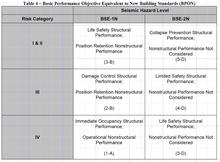Summary
The goal of this project is to assess and recommend options for improving the built environment and critical infrastructure to reflect performance goals stated in terms of post-earthquake reoccupancy and functional recovery time. By limiting damage to the structural and nonstructural systems as well as the building lifelines, buildings could more quickly return to function and be occupied following an earthquake event. Improving the functional recovery of buildings and infrastructure can be achieved through different approaches that can vary in technical or implementation standpoints. The options for improving the built environment and infrastructure would require not only new performance levels (a significant departure from current building code philosophies) but also work with communities and community level infrastructure for mitigation, planning, and recovery actions and preparations. This project is developed to address the legislative language in the National Earthquake Hazards Reduction Program (NEHRP) Act of 2018 (PL 115-307). The final findings of the project will be summarized in a report to Congress. The outcome of this project will identify the way forward for the US to achieve more rapid recovery of the community after earthquakes through functional recovery.
Description
Objective - To develop a report that details the recommended options for improving the built environment and critical infrastructure to reflect performance goals stated in terms of post-earthquake reoccupancy and functional recovery time.
What is the new technical idea?
The technical idea for this project is to improve the performance of the built environment and critical infrastructure across the nation for earthquake events by focusing on the needs for reoccupancy and functional recovery time. Designers, planners, engineers, and communities can then use this information to appropriately develop codes, standards, guidelines, and policies to improve the functional recovery of buildings and infrastructure.
At the present time, buildings are either designed using the prescriptive design or performance-based design approaches. Prescriptive building codes and standards, such as ASCE/SEI 7, adjust design loads for hazards based on the building occupancy, risk category, and/or hazard levels. In the case of earthquake, the Seismic Design Category (SDC) is identified based on the hazard level obtained from USGS, characterizing expected ground shaking, and structural risk category based on occupancy. Although, increasing the loads for the design of the structural frame will reduce the likelihood of structural frame damage, it will not explicitly address the building functionality and recovery time. In addition, the main objective of the prescriptive codes and standards for most of the buildings is to preserve lives of the occupants in a design-level earthquake; these codes do not specifically consider the reoccupancy and timely recovery of building function.
ASCE 7-16 standard allows the use of alternative design approach for buildings. Performance based seismic design (PBSD) is a well-developed alternative design approach that has been used in practice for the last decade. PBSD method specifies performance objectives that are deemed to be implicitly achieved by satisfying Immediate Occupancy, Life Safety and Collapse Prevention performance levels at specified hazard levels, see Table 1. Instead of prescriptive code provisions, this approach relies on increased engineering judgement and analyses together with peer review to verify anticipated performance. Although PBSD warrants achieving a specific performance objective, the common metric used in PBSD for design of buildings are not expressed in terms of recovery time.
Improved performance goals for reoccupancy and functional recovery time that address the entire building, its internal nonstructural systems and its surrounding lifelines can advance codes, standards, and guidelines to better accommodate community interests in improving seismic performance of buildings and infrastructure. A new functional recovery performance goal would reduce damage to the entire building and its contents to levels permitting resumption of building occupancy and function at appropriate intervals. There are multiple options to achieve the desired performance goal of functional recovery for buildings and infrastructure. This project will identify and assess different options to achieve the desired performance goal stated in terms of post-earthquake reoccupancy and functional recovery time for buildings and infrastructure.
Table 1. Requirements for the performance objective equivalent to new buildings as a function of hazard level and risk category (Pekelnicky and Poland, 2012).

What is the research plan?
The project has a focused objective of identifying, assessing, and recommending options to Congress that can improve the built environment and critical infrastructure to reflect performance goals stated in terms of post-earthquake reoccupancy and functional recovery time. Thus, the goal of the effort is help facilitate the identification of options for improving the functional recovery of buildings and critical infrastructure. Accordingly, the following tasks will be addressed:
- Staffing of the effort, including NIST and FEMA personnel, and outside contractors.
- Developing the project plan in conjunction with FEMA.
- Developing the contract package for holding the stakeholder meetings.
- Identification of the Committee of Experts (detailed in footnote 1 above). The Committee of Experts will include a project technical panel and a project review panel.
- Holding a series of remote and in-person meetings for the committee of experts to gather feedback for identifying and assessing options for functional recovery.
- Holding a minimum of two meetings with the review panel of the committee.
- Holding five stakeholder meetings in Saint Louis, Salt Lake City, Seattle, San Francisco, and Los Angeles to collect information and ideas on the identification and assessment of options for functional recovery. The information collected at the stakeholder meetings will be presented to the Committee of Experts.
- Developing the NIST-FEMA report to Congress.
NIST team will significantly contribute to every step of the project.

